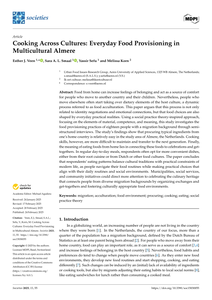Increasing attention has been paid to the ‘voice’ of people living with mild cognitive impairment (or dementia, but there is a lack of clarity about how everyday life is perceived from this insiderinsider’s perspective. This study aimed to explore the everyday life experiences, challenges and facilitators of individuals with MC I and dementia living at home.
DOCUMENT

Increasing attention has been paid to the ‘voice’ of people living with mild cognitive impairment (MCI) or dementia, but there is a lack of clarity about how everyday life is perceived from this insider’s perspective. This study aimed to explore the everyday life experiences, challenges and facilitators of individuals with MCI and dementia living at home. A scoping review of qualitative studies, guided by the Joanna Briggs Institute Reviewers Manual, was conducted. Eight databases were searched, resulting in 6345 records, of which 58 papers published between 2011 and 2021 were included. Analysis was carried out by descriptive content analysis. Findings were categorized into seven spheres of everyday life: experiences related to the condition, self, relationships, activities, environment, health and social care and public opinions. The results show many disruptions and losses in everyday life and how people try to accommodate these changes. In all areas of everyday life, people show a deep desire to have reciprocal relationships, stay engaged through participation in activities and have a sense of belonging in the community. However, more research is needed on the factors that promote and impede the sense of reciprocity and belonging.
MULTIFILE

"Objectives: Research on what matters most to people with dementia is crucial for developing tailored interventions and support. This study explored how people with dementia experience their everyday lives, providing insight into what is important to them to live the best they can at home. Methods: Inspired by a phenomenological approach, open interviews were conducted with 15 people with dementia, supplemented by home tours and walking interviews. Data collection included one to three sessions per participant. Data were analysed using descriptive content analysis and followed the phases of open, axial, and selective coding. A co‐researcher group of seven people with dementia was consulted during the analysis to help interpret the emergent findings. Findings: Six dimensions of what matters most in everyday life were identified: 1) Engaging in meaningful activities, which included routines, household chores, leisure, day activities, and volunteering or work; 2) Keeping a sense of connection, in relationships within the home, with family, friends, groups, and the neighbourhood; 3) Having a sense of belonging, which included attachments inside and outside the home, and to cherished objects; 4) Connecting to self, which included the ability to reflect on past experiences, live in the present moment and anticipate the future; 5) Adjusting to ongoing changes, which included alterations in sensory perceptions, perceptions of the physical environment, and navigating shifts in interpersonal dynamics; 6) Being open to help and support, from professionals, community and society. Conclusions: For people with dementia, everyday life is a continuous balancing act between what matters most and what can be achieved daily. This is not only related to dementia but is also embedded in the wider perspective of life history, relational networks, and the physical environment. This study highlights the importance of identifying what matters most to people with dementia to provide person‐centred support."
MULTIFILE

Sharing platforms gained importance in recent years. Little is known about whether and why novel means to digitally share meals are incorporated into people’s everyday portfolios of everyday food provisioning. The objective of this paper is accordingly to explore why digitally mediated meal sharing is incorporated (or not) into an array of everyday food provisioning practices. We use observations of and interviews with users of the Dutch platform Thuisgekookt, on which home cooks offer meals to be picked up by neighbors. Three teleoaffective episodes - anticipating, actualizing and assessing - assist in explaining why meal sharing recruits practitioners (or not).
LINK
In the Netherlands, where this study was conducted, there are around 800,000 family carers of people with dementia. Research into the needs and priorities of people with dementia and their family carers is crucial for developing tailored care and meaningful support. However, current research lacks attention to the everyday life experiences of caring for someone with dementia at home. Therefore, the research question this study aimed to address was: how do family carers of people with dementia living at home approach and experience their everyday life in a caring context?
MULTIFILE
OBJECTIVE: to gain insight into what older adults after hip fracture perceive as most beneficial to their recovery to everyday life.DESIGN: qualitative research approach.SETTING: six skilled nursing facilities.PARTICIPANTS: 19 older community dwelling older adults (aged 65-94), who had recently received geriatric rehabilitation after hip fracture.METHODS: semi-structured interviews were conducted with 19 older adults after hip fracture. Coding techniques based on constructivist grounded theory were applied.RESULTS: four categories were derived from the data: 'restrictions for everyday life', 'recovery process', 'resources for recovery' and 'performing everyday activities'. Physical and psychological restrictions are consequences of hip fracture that older adults have struggled to address during recovery. Three different resources were found to be beneficial for recovery; 'supporting and coaching', 'myself' and 'technological support'. These resources influenced the recovery process. Having successful experiences during recovery led to doing everyday activities in the same manner as before; unsuccessful experiences led to ceasing certain activities altogether.CONCLUSION: participants highlight their own role ('myself') as essential for recovery. Additionally, coaching provides emotional support, which boosts self-confidence in performing everyday activities. Furthermore, technology can encourage older adults to become more active and being engaged in the recovery process. The findings suggest that more attention should be paid to follow-up interventions after discharge from inpatient rehabilitation to support older adults in finding new routines in their everyday activities.A conceptual model is presented and provides an understanding of the participants' experiences and perspectives concerning their process of recovery after hip fracture to everyday life.
DOCUMENT

In this inaugural speech, Dr. Wertheim-Heck takes take you to themundane and often inconspicuous nature of our daily foodconsumption: our everyday fare. I believe that this holds animportant key for a successful transition towards a moresustainable, healthy and inclusive food system for the city. The author starts by giving a historical perspective with a personal slant. She then elaborates on the specific context of cities in transition towards a more sustainable, healthy, and inclusive food system. This will be linked to the specific context of Almere and the brief for the author's professorship within Food and Healthy living at Aeres University of Applied Sciences Almere
DOCUMENT

The influence of mutual spousal interrelations in domains such as health and wellbeing has been demonstrated, but little is known about the domain of everyday activities of couples in late life. In the present explorative study, we considered all of the activities participating couples talked about to be their everyday activities. Its aim was to understand, over time, changes in everyday activities as experienced by late-life community-dwelling couples. In a two-year period, 41 individual and joint interviews were conducted with 8 couples, who were purposefully selected from the Longitudinal Aging Study Amsterdam. Analyses involved the construction of couple narratives and constant comparisons within and across couples. Changing everyday activities in late-life couples was interpreted to be a two-way process of (1) converging, and (2) keeping up, which occurred in three fluid phases. Converging was a slow inward movement with a shift towards diminished everyday activities performed in a smaller world. Keeping up was an outward movement in order to resist the converging process by using everyday activities as a means to keep fit, physically and mentally, and to connect with the wider social world. In the first phase, couples maintained their unique linked activity pattern. In the second phase, spouses resisted converging by keeping up. In the third phase, spouses co-performed everyday activities closely together. The findings support the need to develop couple-oriented interventions that aim to enhance the couples' functioning in the domain of everyday activities.
DOCUMENT
Food from home can increase feelings of belonging and act as a source of comfortfor people who move to another country and their children. Nevertheless, people whomove elsewhere often start taking over dietary elements of the host culture, a dynamicprocess referred to as food acculturation. This paper argues that this process is not only related to identity negotiations and emotional connections, but that food choices are also shaped by everyday practical realities. Using a social practice theory-inspired approach, focusing on the elements of material, competence, and meaning, this study investigates the food provisioning practices of eighteen people with a migration background through semistructured interviews.Keywords: migration; acculturation; food environment; procuring; cooking; eating; social practice theory
DOCUMENT

Marfan syndrome (MFS) is a multisystemic, autosomal dominant connective tissue disorder that occurs de novo in 25%. In many families, parent and child(ren) are affected, which may increase distress in parents. To assess distress, 42 mothers (29% MFS) and 25 fathers (60% MFS) of 43 affected children, completed the validated screening‐questionnaire Distress thermometer for parents of a chronically ill child, including questions on overall distress (score 0–10; ≥4 denoting “clinical distress”) and everyday problems (score 0–36). Data were compared to 1,134 control‐group‐parents of healthy children. Mothers reported significantly less overall distress (2, 1–4 vs. 3, 1–6; p = .049; r = −.07) and total everyday problems (3, 0–6 vs. 4, 1–8; p = .03; r = −.08) compared to control‐group‐mothers. Mothers without MFS reported significantly less overall distress compared to mothers with MFS, both of a child with MFS (1, 0–4 vs. 3.5, 2–5; p = .039; r = −.17). No significant differences were found between the father‐groups, nor between the group of healthy parents of an affected child living together with an affected partner compared to control‐group‐parents. No differences in percentages of clinical distress were reported between mothers and control‐group‐mothers (33 vs. 42%); fathers and control‐group‐fathers (28 vs. 32%); nor between the other groups. Distress was not associated with the children's MFS characteristics. Concluding, parents of a child with MFS did not show more clinical distress compared to parents of healthy children. However, clinical distress was reported in approximately one‐third and may increase in case of acute medical complications. We advise monitoring distress in parents of a child with MFS to provide targeted support.
DOCUMENT
